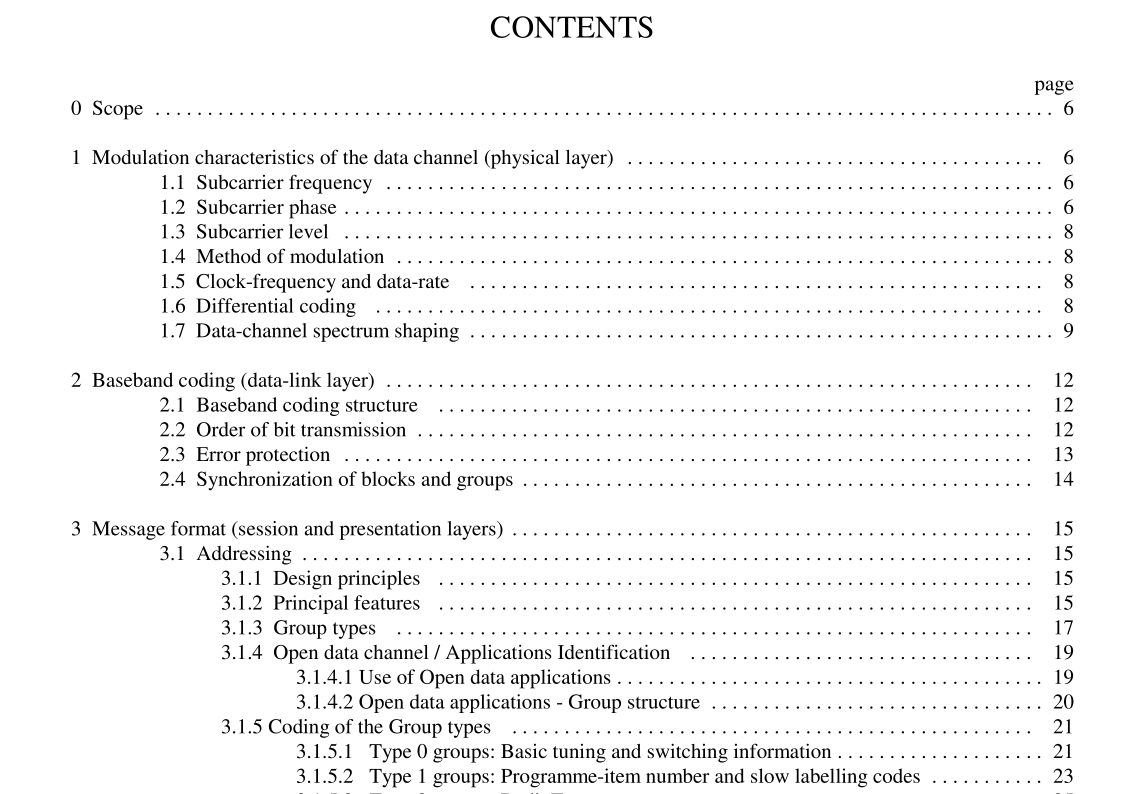IEC 62106 pdf download

IEC 62106 pdf download.Specification of the radio data system (RDS) for VHF/FM sound broadcasting in the frequency range from 87,5 to 108,0 MHz
1 Modulation characteristics of the data channel (physical layer)
The Radio Data System is intended for application to VHF/FM sound broadcasting transmitters in the range 87.5 to 108.0 MHz, which carry stereophonic (pilot-tone system) or monophonic sound broadcasts (see ITU-R Recommendation BS.450-2). It is important that radio-data receivers are not affected by signals in the multiplex spectrum outside the data channel. The system can be used simultaneously with the ARI (Autofahrer-Rundfunk-Information) system (see annex H), even when both systems are broadcast from the same transmitter. However, certain constraints on the phase and injection levels of the radio-data and ARI signals must be observed in this case (see 1.2 and 1.3). The data signals are carried on a subcarrier which is added to the stereo multiplex signal (or monophonic signal as appropriate) at the input to the VHF/FM transmitter. Block diagrams of the data source equipment at the transmitter and a typical receiver arrangement are shown in figures 1 and 2, respectively. 1.1 Subcarrier frequency During stereo broadcasts the subcarrier frequency will be locked to the third harmonic of the 19-kHz pilot-tone. Since the tolerance on the frequency of the 19-kHz pilot-tone is ± 2 Hz (see ITU-R Recommendation BS.450-2), the tolerance on the frequency of the subcarrier during stereo broadcasts is ± 6 Hz. During monophonic broadcasts the frequency of the subcarrier will be 57 kHz ± 6 Hz. 1.2 Subcarrier phase During stereo broadcasts the subcarrier will be locked either in phase or in quadrature to the third harmonic of the 19 kHz pilot-tone. The tolerance on this phase angle is ± 10 , measured at the modulation input to the FM transmitter. In the case when ARI and radio-data signals are transmitted simultaneously, the phase angle between the two subcarriers shall be 90 ± 10 .
1.3 Subcarrier level The deviation range of the FM carrier due to the unmodulated subcarrier is from ± 1.0 kHz to ± 7.5 kHz. The recommended best compromise is ± 2.0 kHz 1 ). The decoder/demodulator shall also operate properly when the deviation of the subcarrier is varied within these limits during periods not less than 10 ms. In the case when ARI (see annex H) and radio-data signals are transmitted simultaneously, the recommended maximum deviation due to the radio-data subcarrier is ± 1.2 kHz and that due to the unmodulated ARI subcarrier shall be reduced to ± 3.5 kHz. The maximum permitted deviation due to the composite multiplex signal is ± 75 kHz. 1.4 Method of modulation The subcarrier is amplitude-modulated by the shaped and biphase coded data signal (see 1.7). The subcarrier is suppressed. This method of modulation may alternatively be thought of as a form of two-phase phase-shift-keying (psk) with a phase deviation of ± 90 . 1.5 Clock-frequency and data-rate The basic clock frequency is obtained by dividing the transmitted subcarrier frequency by 48. Consequently, the basic data-rate of the system (see figure 1) is 1187.5 bit/s ± 0.125 bit/s.
The above description of the error protection may be regarded as definitive, but further explanatory notes on the generation and theory of the code are given in annexes B and C . The error-protecting code has the following error-checking capabilities [3, 4] : a) Detects all single and double bit errors in a block. b) Detects any single error burst spanning 10 bits or less. c) Detects about 99.8% of bursts spanning 11 bits and about 99.9% of all longer bursts. The code is also an optimal burst error correcting code [5] and is capable of correcting any single burst of span 5 bits or less. 2.4 Synchronisation of blocks and groups The blocks within each group are identified by the offset words A, B, C or C’ and D added to blocks 1, 2, 3, and 4 respectively in each group (see annex A). The beginnings and ends of the data blocks may be recognized in the receiver decoder by using the fact that the error-checking decoder will, with a high level of confidence, detect block synchronisation slip as well as additive errors. This system of block synchronisation is made reliable by the addition of the offset words (which also serve to identify the blocks within the group). These offset words destroy the cyclic property of the basic code so that in the modified code, cyclic shifts of codewords do not give rise to other codewords [6, 7]. Further explanation of a technique for extracting the block synchronisation information at the receiver is given in annex C.









